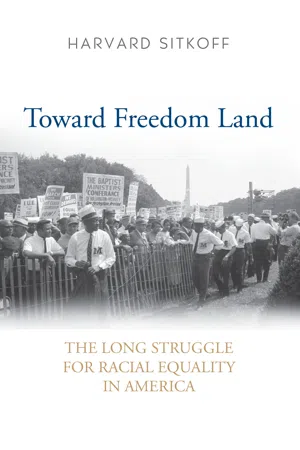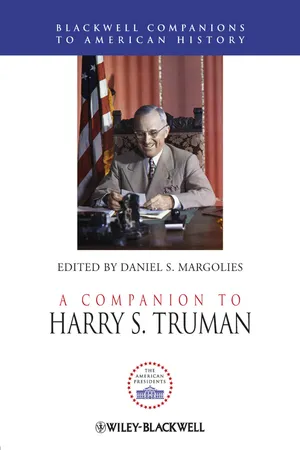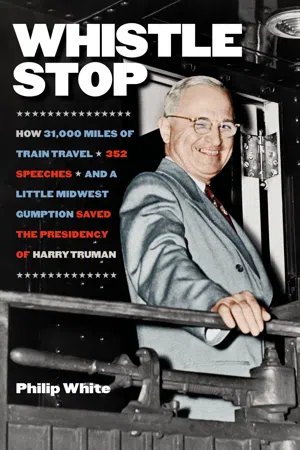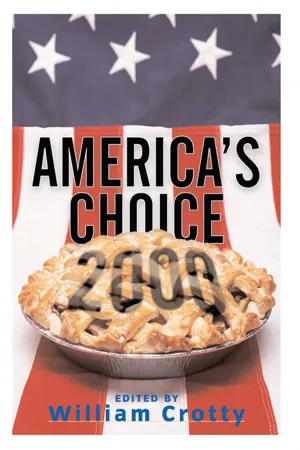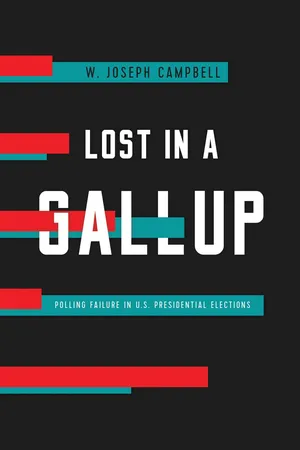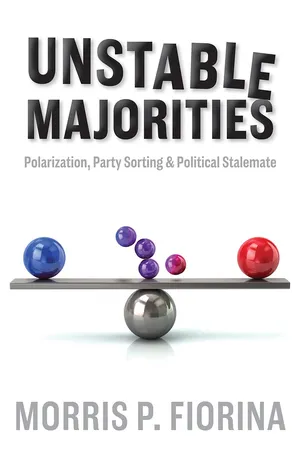History
1948 Presidential Election
The Presidential Election of 1948 in the United States was a significant political event. Incumbent President Harry S. Truman, a Democrat, ran against Republican Thomas E. Dewey and others. The election is notable for Truman's unexpected victory, which defied the predictions of many pollsters and newspapers. This election also saw the emergence of the States' Rights Democratic Party, or Dixiecrats, led by Strom Thurmond.
Written by Perlego with AI-assistance
Related key terms
1 of 5
8 Key excerpts on "1948 Presidential Election"
- eBook - ePub
US Presidential Elections and Foreign Policy
Candidates, Campaigns, and Global Politics from FDR to Bill Clinton
- Andrew Johnstone, Andrew Priest, Andrew Johnstone, Andrew Priest(Authors)
- 2017(Publication Date)
- The University Press of Kentucky(Publisher)
3 Containing Challenges The Triumphs of Harry Truman in the Presidential Election of 1948Michael F. HopkinsThe presidential election of 1948 is famous for being a great upset, epitomized by the headline of the early edition of the Chicago Daily Tribune on November 3: “Dewey Defeats Truman.” Harry Truman, of course, won the election; and he joyfully posed with this edition of the newspaper as he celebrated his victory. The editorial was not as inept as it now seems. Polls favored Truman’s Republican opponent, Thomas Dewey. Many Democrats did not expect Truman’s victory—the Harvard historian Arthur Schlesinger described himself as “somewhat stunned” by the outcome.1 A printers’ strike made the task of producing a paper after the polls closed a major headache.2The substantial literature on 1948 is characterized by a focus on the surprising outcome and has frequently placed an emphasis on the plucky performance by the president. Most studies have concentrated on the various domestic components in the result. This pattern was set when, soon after the election, journalists tried to account for the failure to predict Truman’s victory. The New Republic attributed the result to the continued support of the Democratic candidate by the coalition of groups built up by Roosevelt: “Harry Truman won because Franklin Roosevelt had worked so well.”3 Samuel Lubell in the Saturday Evening Post narrowed this down to one particular part of this coalition. He declared: “[Given] the closeness of the 1948 election, the German-American swing can definitely be credited with giving Truman his margin of victory.”4 Journalists wrote the first book-length studies: Jules Abels in 1959 and Irwin Ross in 1968. Their titles convey an emphasis on the significant contribution of Truman.5 A substantial article by Richard S. Kirkendall in a major edited study followed these.6 The first major academic studies appeared in the 1990s—the volumes by Harold I. Gullan and Gary A. Donaldson. These were followed by the works of Zachary Karabell and David Pietrusza. Andrew E. Busch’s study was published in 2012, and Thomas W. Devine’s assessment of Wallace’s role in the election appeared in 2013.7 - eBook - ePub
Toward Freedom Land
The Long Struggle for Racial Equality in America
- Harvard Sitkoff(Author)
- 2010(Publication Date)
- The University Press of Kentucky(Publisher)
Harry Truman andthe Election of 1948The Coming of Age of Civil Rightsin American Politics
Yet another essay written in the late 1960s, when I proudly considered myself a New Leftist, “Harry Truman and the Election of 1948” began as a bill of indictment, a categorical denunciation of liberals for doing too little, too late. It then became a critique of Truman as, at best, a reluctant champion of civil rights, pressured by forces beyond his control. It concluded, nevertheless, with civil rights benefiting from being identified with the president of the United States and with the Democratic Party. All motives aside, that sparked ever-rising expectations of African Americans and ever-increasing pressures on the political system to respond to those expectations. Indicative of the then swelling tide of revisionism, characterized by a strong animosity toward American liberalism, “Harry Truman and the Election of 1948” was awarded the Fletcher M. Green Award for best essay submitted by a graduate student to theJournal of Southern History,1970–1972. Written in the same period, but a more radical statement of the revisionist case against liberalism in general and against the significance of Truman’s civil rights program in particular, is my “Years of the Locust: Interpretations of Truman’s Presidency since 1965,” inThe Truman Period as a Research Field: A Reappraisal, 1972,ed. Richard Kirkendall (Columbia: University of Missouri Press, 1974), 75–112. “Harry Truman and the Election of 1948: The Coming of Age of Civil Rights in American Politics” was originally published inJournal of Southern History 37 (November 1971), 597–616 .A year before the national election of 1948 Clark M. Clifford, an administrative assistant and special counsel to the president, presented a forty-three-page confidential memorandum to Harry S. Truman. The memo, referred to as “The Politics of 1948,” suggested the electoral strategy for Truman in the upcoming election. Clifford particularly emphasized the importance of the Negro vote, warning that because of Henry A. Wallace’s growing identification with the civil rights issue and Thomas E. Dewey’s presumed popularity with Negro leaders, as well as the Republican policy of embarrassing the Democrats by publicly favoring anti–poll tax and antilynching legislation, Truman would lose the Negro vote unless he acted decisively. “Unless there are new and real efforts,” wrote Clifford, “(as distinguished from mere political gestures which are today thoroughly understood and strongly resented by sophisticated Negro leaders), the Negro bloc . . . will go Republican.” In order to outbid the Republicans and steal Henry Wallace’s thunder, the president must “go as far as he feels he possibly could go in recommending measures to protect the rights of minority groups.” Administration strategy must be premised on the assumption that “it will get no major part of its program approved. Its tactics must, therefore, be entirely different than if there were any real point to bargaining and compromise. Its recommendations . . . must be tailored for the voter, not the Congressman; they must display a label which reads ‘no compromises.’” Clifford confidently predicted that Truman’s espousal of civil rights would not lose him southern support. “As always, the South can be considered safely Democratic,” he concluded, “and in formulating national policy, it can be safely ignored.”1 - eBook - ePub
Presidential Campaigns
Documents Decoded
- Daniel M. Shea, Brian M. Harward(Authors)
- 2013(Publication Date)
- ABC-CLIO(Publisher)
Truman on Civil Rights
President Harry Truman—s Special Message to Congress on Civil Rights
February 2, 1948INTRODUCTIONWhen many Americans think about the Civil Rights Movement, the 1960s springs to mind. This makes good sense, given that many of the most important demonstrations and public events occurred during this decade in which important legislation was passed. Martin Luther King Jr.—s “I Have a Dream” speech was delivered in August 1963, the Civil Rights Act was passed in 1964, and the Voting Rights Act was affirmed one year later. The 1960s was indeed a critical decade in the fight for racial equality in America.Yet the battle for equality moved slowly for decades before these important changes, and on inspection we find that 1948 was a critical year and that its impact would be felt in the 1952 presidential election. A few significant things happened that year. First, President Harry Truman offered the nation a stern, frank assessment on the state of race relations in America in a message delivered to Congress in February. The following is an excerpt from that speech.Second, a bit later that year, Truman issued an executive order requiring the integration of the armed forces.Finally, in the summer of 1948 at the Democratic National Convention, a powerful address was delivered by Minnesota senator (and future vice president) Hubert Humphrey on race relations. He called for legislation to end lynching, job discrimination on the basis of skin color, and school segregation in the South. So again, 1948 was an important year in the struggle to end racial discrimination.From an electoral vantage, the focus on civil rights by Democrats, such as Truman and Humphrey, drove a wedge in the party. Simply stated, the South, a key part of the New Deal Coalition and the key to success for Democratic presidential candidates, began to shift toward the Republican Party because of efforts of this sort. This address is noted here—in a collection of pieces on the 1952 election—because it propelled that breakup. - eBook - ePub
- Daniel S. Margolies(Author)
- 2012(Publication Date)
- Wiley-Blackwell(Publisher)
The Truman campaign was far superior to that of Dewey. The governor's complacency, rigidity, and lack of imagination prevented him from adjusting to shifting political tides. “He is by nature cute but cautious,” Mencken stressed, “He is a good trial lawyer, but an incompetent rabble-rouser” (Goulden, 1976: 134). When a Republican member of Congress warned Dewey that the president was making inroads with farmers, the governor declined to change tactics and “continued to take solace in the favorable poll numbers” (Witcover, 2003: 434). Truman's campaign, in contrast, blended fastidiousness with flexibility. “Truman was surrounded by one of the most impressive teams of campaign managers ever assembled,” Karabell (2000) pointed out. “He was carefully briefed and skillfully counseled, and his acute political instincts enabled him to utilize advice that would be helpful” (p. 259). Such instincts allowed the president to exploit the governor's mistakes and to minimize his own. When, for example, Dewey assailed the engineer of his train as a “lunatic” for accidentally backing up into a crowd, Truman invoked one of the GOP's least popular figures, Herbert Hoover: “He objects to having engineers back up. He doesn't mention, however, that under the ‘Great Engineer’ we backed up into the worst depression in our history” (Donovan, 1977: 427). The president brushed aside his major lapse of the campaign, his aborted effort to send Chief Justice Fred Vinson to Moscow to initiate talks with Stalin. In general, international events worked to Truman's advantage or, as one Dewey adviser lamented, “the bear got us” (Offner, 2002: 266). Even the historian Arnold A. Offner (2002), a strong critic of the administration's diplomacy, conceded: “the president's handling of the Berlin crisis, despite the Vinson mission gaffe, helped to strengthen his claim to foreign policy leadership” (p. 266).The Election in Retrospect
As Karabell (2000: 257) has noted, there were many reasons why Truman won the 1948 election, and no consensus among scholars on which factor was decisive. Often overlooked was the fact that incomes were rising and unemployment was low. “Incumbent presidents,” Karabell explained, “almost never lose when the economy is strong, and in 1948, the country was prosperous and becoming more so” (pp. 258–9). The historian Lewis L. Gould (2003) concurred. “When the year began,” he asserted, “the fundamentals appeared to be on the side of Truman. The nation was prosperous and once again at peace within the context of the Cold War” (p. 313). Yet pollsters were oblivious to this fact, and they got the election wrong. “The pollsters,” Karabell (2000) argued, “truly believed that the outcome of an election could be known months before it actually took place” (p. 94). In September 1948, Elmo Roper, on the basis of a survey that had Dewey leading Truman 44 to 31 percent, pronounced the election all but over. He no doubt adhered to “Farley's Law,” brainchild of former Democratic National Committee Chair James A. Farley, which held that “voters made up their minds by early September at the latest” (Karabell, 2000: 199). George Gallup's final poll (October 30) gave the election to Dewey by a margin of 49.5 to 44.5 percent (Donaldson, 1999: 209). Life declared the governor “The Next President,” and Alistair Cooke, just before the election, published a postmortem in the Manchester Guardian (U.K.) entitled “Harry Truman: A Study in Failure” (Donaldson, 1999: 252). Aside from the Chicago Tribune's “Dewey Defeats Truman” headline, perhaps the most embarrassing prediction was a survey, conducted by Newsweek - eBook - ePub
Whistle Stop
How 31,000 Miles of Train Travel, 352 Speeches, and a Little Midwest Gumption Saved the Presidency of Harry Truman
- Philip White(Author)
- 2014(Publication Date)
- ForeEdge(Publisher)
THE ELECTION OF 1948H arry Truman was never supposed to be president of the United States. Born in humble circumstances to farmers in Lamar, Missouri—pronounced “Missour-uh” by its residents—he didn’t go to college, but instead tilled the land like his father and worked as a speculator, a bank clerk, and the coproprietor of a men’s clothing store. These jobs came on either side of a formative stint serving as a captain of artillery in the fields of France during World War I, where Truman impressed his fellow soldiers with his calm demeanor and refusal to join their flight from heavy enemy fire.Truman survived his military service with nary a scratch, but, like his father, he was not so lucky in business. His Kansas City haberdashery fell victim to the economic tremor of 1920–21 that preceded the 1929 fiscal earthquake, and his mine investment and attempts to save the family farm fared little better.As he struggled to make headway in his professional life, Truman turned to a vocation that had fascinated him since he saw the great populist William Jennings Bryan deliver an impassioned speech at the 1900 Democratic National Convention in Kansas City: politics. With close friends staffing his campaigns, Truman was elected as Jackson County judge (in this case, more of an administrative position than a judicial one) in 1933 and, with the backing of influential Kansas City boss Tom Pendergast, as a US senator in 1935. After a moderately successful though not outstanding first term, Truman won re-election to the Senate by just over eight thousand votes in a bitterly contested 1940 election. He then made his mark by chairing what soon became known as the “Truman Committee,” which saved the government billions by eliminating inefficient wartime contracts and minimizing profiteering. - eBook - ePub
America's Choice 2000
Entering A New Millenium
- William Crotty(Author)
- 2018(Publication Date)
- Routledge(Publisher)
Eight The Election in Perspective: Two Nations, Four PartiesJohn Kenneth WhiteTHE 2OOO PRESIDENTIAL ELECTION WILL BE FOREVER REMEM -bered not for what the candidates said or did during the campaign, but for how it ended. Not since the disputed Hayes-Tilden contest of 1876 has there been so much drama, confusion, and excitement. The trouble began on election night, when the broadcast network projections gave the state of Florida to AI Gore, then to George W. Bush, then to nobody. It only got worse when the same networks called the presidency for Bush only to take back their declaration a few hours later. And it ended when, for the first time in history, the Supreme Court of the United States determined the winner. But that body's certification of George W. Bush as the nation's 43rd President was not a triumph for our democracy or its institutions; rather, it happened only because Al Gore and the Democrats reluctantly surrendered.When it comes to selecting a president, Americans want the process to be both fair, yet provide for majority rule; deliberative as well as quick; representative, but with some having a greater voice than others. Viewed from this perspective, the 2000 election failed on all counts. Many did not see the electoral count as fair; rather, the candidate who won the popular vote did not become president. It was neither deliberative, as the courts rushed to beat the clock set by the Congress and the Florida legislature. Nor was it quick, as the turmoil dragged on for five weeks after the balloting. Finally, the five members of the Supreme Court that foreclosed all recounts were not the "greater voices" either the voters or the framers had in mind. AI Gore, correctly, did not hail George W. Bush on his election, rather he congratulated Bush "on becoming the 43rd president of the United States."1 There is a difference. Because Bush was confirmed by the Supreme Court, his becoming president is likely to be an even more daunting task than it was for Gerald R. Ford, the first man to serve who had neither stood for the presidency nor the vice presidency. Ford's ascension came as a result of a decision by elected officials to remove the corrupt Richard M. Nixon from office—a process that most Americans accepted as legitimate. Bush, on the other hand, enters the White House thanks to the unelected members of the Supreme Court. The result is a serious erosion of public trust. A disturbing 48 percent say their confidence in the election system has been seriously shaken, and an even more alarming 37 percent claim that Bush is not a legitimate president.2 - eBook - ePub
Lost in a Gallup
Polling Failure in U.S. Presidential Elections
- W. Joseph Campbell(Author)
- 2020(Publication Date)
- University of California Press(Publisher)
28Nor did other prominent journalists consider the prospect of an upset. The brothers Joseph and Stewart Alsop declared in their syndicated column written before but published the day after the election, “The first postelection question is how the Government can get through the next 10 weeks. . . . Events will not wait patiently until Thomas E. Dewey officially replaces Harry S. Truman.”29Early editions of the Washington Post published a glowing, day-after-the-election profile of Dewey, whom the newspaper called the “president-elect.” The article said: “A vigorous trait, rooted in the traditions of our pioneer forefathers, dominates the scintillating success story of Thomas Edmund Dewey, yesterday elected to become the thirty-third president of the United States. That trait is persistence.” The profile declared in closing, “This same trait, victorious Republicans believe, will make him a great president.”30Faint challenges to the campaign’s dominant narrative arose here and there before the election. These objections were typically muffled, or offered whimsically. In mid-July 1948, Earl Wilson, the New York Post ’s gossip and nightlife columnist, polled one hundred New Yorkers and tourists at restaurants, bars, and cafes near Broadway. Wilson reported that his impromptu survey had Truman in the lead, 45–41. The survey, unrepresentative though it was, “is guaranteed to be as accurate as the Gallup Poll or a Ouija board,” Wilson wrote.31Another murmur came from Jennings Perry, a liberal columnist for the New York Star. A week before the election, Perry wrote that “the vote is going to be closer than you think” between Dewey and Truman. He offered no evidence for his assessment, beyond his impressions that the president had probably narrowed the gap “by being peppery, by sticking to his guns, by getting out of the White House and taking his show on the road. . . . He no longer appears futile, no matter what the polls report, since he has made himself the symbol of the real virility of his party.”32 - eBook - ePub
Unstable Majorities
Polarization, Party Sorting, and Political Stalemate
- Morris P. Fiorina(Author)
- 2017(Publication Date)
- Hoover Institution Press(Publisher)
Coming Apart: An Informal History of America in the 1960s (New York: Quadrangle, 1973).2 . In 1928, the Democratic candidate was Catholic Al Smith of New York. Religious, ethnic, and urban-rural divisions dominated the election. As noted in chapter 4, much of the politics of the late nineteenth century revolved around ethnocultural divisions.3 . See the debate sparked by Jim Rutenberg, “Trump Is Testing the Norms of Objectivity in Journalism,” New York Times , August 7, 2016, www.nytimes.com/2016/08/08/business/balance-fairness-and-a-proudly-provocative-presidential-candidate.html?_r=0 .4 . Nate Silver, “The Invisible Undecided Voter,” FiveThirtyEight , January 23, 2017, fivethirtyeight.com/features/the-invisible-undecided-voter/.5 . Amanda Taub, “The Rise of American Authoritarianism,” www.vox.com/2016/3/1/11127424/trump-authoritarianism ; cf. Wendy Rahn and Eric Oliver, “Trump’s Voters Aren’t Authoritarians, New Research Says. So What Are They?” Washington Post , March 9, 2016, https://www.washingtonpost.com/news/monkey-cage/wp/2016/03/09/trumps-voters-arent-authoritarians-new-research-says-so-what-are-they/ .6 . Christina Cauterucci, “In 2016, America Was Forced to Face the Reality of Sexual Assault,” Slate , December 28, 2016, www.slate.com/blogs/xx_factor/2016/12/28/_2016_was_the_year_america_learned_what_sexual_assault_looks_like.html .7 . Jenee Desmond-Harris, “Trump’s Win Is a Reminder of the Incredible, Unbeatable Power of Racism,” Vox , November 9, 2016, www.vox.com/policy-and-politics/2016/11/9/13571676/trump-win-racism-power .8 . Conversely, large changes in the vote can have minimal consequences for institutional control and policy change. Ronald Reagan gained 8 percentage points in the popular vote between 1980 and 1984, but the large Democratic majority in the House diminished by only sixteen seats and the narrow Republican majority in the Senate fell by one.9 . Parliamentary systems have no equivalent to our midterm elections.10 . Publius Decius Mus, “The Flight 93 Election,” CRB
Index pages curate the most relevant extracts from our library of academic textbooks. They’ve been created using an in-house natural language model (NLM), each adding context and meaning to key research topics.

